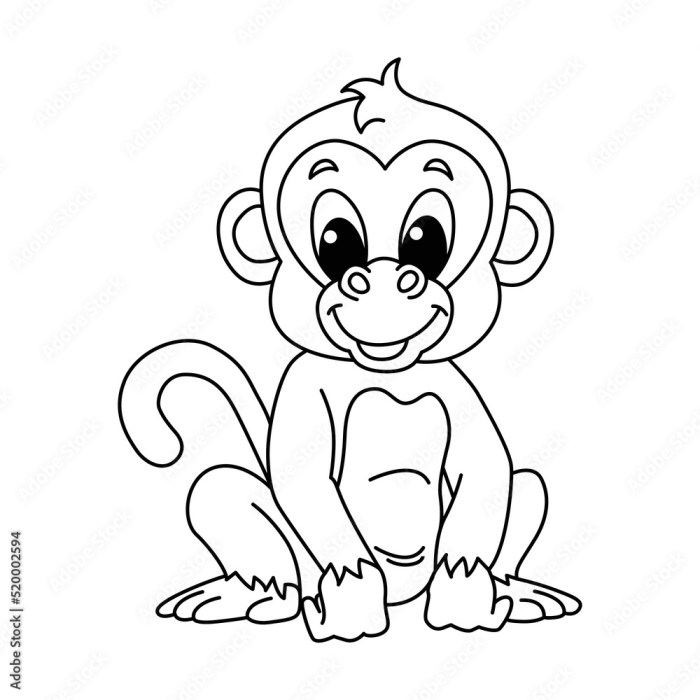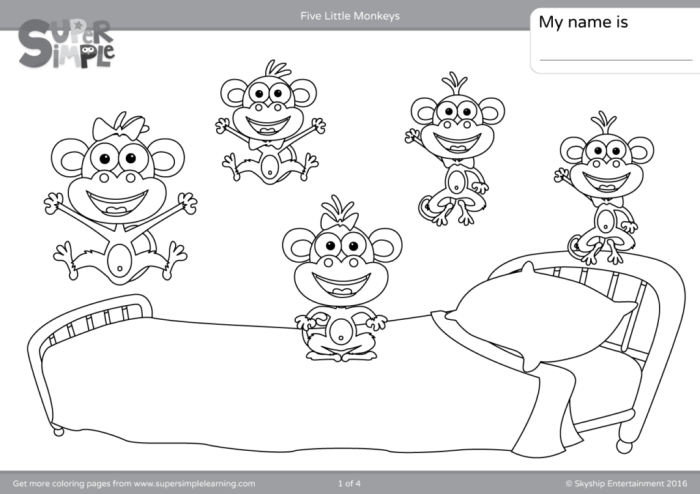Themes and Imagery

Coloring book pictures of monkeys – Hey, dude! So, we’re diving into the rad world of monkey coloring book illustrations, right? Think vibrant jungles, cheeky primates, and a whole lotta creative freedom. Let’s explore the common themes and imagery that make these coloring books so awesome.Monkey coloring book illustrations often tap into a variety of themes, reflecting both the playful nature of monkeys and their symbolic significance across cultures.
The imagery used is incredibly diverse, ranging from realistic depictions to more whimsical and cartoonish styles. We’ll be checking out how positive and negative space are used to create different moods and effects in these designs.
Jungle Settings
Jungle settings are a super common theme, providing a rich backdrop for monkey adventures. Lush green foliage, towering trees, vibrant flowers, and winding vines create a visually appealing environment. The monkeys are often shown swinging through the trees, playing amongst the leaves, or foraging for food. This creates a sense of freedom and wildness, reflecting the natural habitat of these creatures.
Imagine a coloring page with a detailed, layered jungle canopy, where monkeys playfully leap between branches – a total vibe, right? The complexity of the jungle setting provides lots of space for creative coloring.
Playful Monkeys
Playful monkeys are another recurring theme. These illustrations often depict monkeys engaging in various activities, like swinging from branches, grooming each other, or playfully chasing each other. The expressions on the monkeys’ faces are often exaggerated to enhance their playful nature, making them relatable and endearing to children. Think of a page with a bunch of monkeys having a banana-fueled party – pure chaotic fun! The focus here is on the energy and dynamic movements of the monkeys.
Symbolic Meanings of Monkeys
Monkeys in various cultures hold different symbolic meanings. In some cultures, they represent mischief and playfulness, while in others they symbolize intelligence, adaptability, or even spiritual enlightenment. Coloring book illustrations may subtly or overtly incorporate these symbolic meanings through their depiction of the monkeys and their environment. For example, a monkey meditating under a waterfall might subtly hint at spiritual aspects, while a mischievous monkey stealing a banana might highlight a more playful interpretation.
Positive and Negative Space
The use of positive and negative space is crucial in monkey coloring book designs. Positive space refers to the areas occupied by the monkeys and other elements, while negative space is the empty space surrounding them. Some designs emphasize positive space, featuring detailed illustrations of monkeys and their environment. Others utilize negative space more effectively, allowing the viewer’s eye to focus on the monkeys and creating a sense of openness and freedom.
Consider a design with a single monkey silhouetted against a vast, open sky – the negative space emphasizes the monkey’s solitude and freedom. Conversely, a busy scene with multiple monkeys interacting in a dense jungle showcases a more positive space approach.
Themes and Visual Representations
Here’s a quick rundown of some common themes and how they’re visually represented:
- Jungle Adventure: Monkeys swinging through vines, lush foliage, waterfalls, vibrant flowers.
- Monkey Family: A mother monkey with her baby, monkeys grooming each other, showing family bonds.
- Mischief and Play: Monkeys stealing fruit, pulling faces, engaging in playful chases.
- Spiritual Connection: A monkey meditating, surrounded by peaceful natural elements.
- Tribal Monkeys: Monkeys dressed in tribal attire, participating in tribal rituals, representing cultural heritage.
Illustrative Examples: Coloring Book Pictures Of Monkeys

Let’s get this party started with some seriously rad monkey coloring page ideas, Bali style! Think vibrant colors, intricate details, and a whole lotta fun. We’re talking about designs that’ll make your crayons sing!A monkey swinging from a vine is a classic, but we can make it epic.
A Monkey Swinging from a Vine
Imagine a cheeky macaque, its fur a rich, textured brown, swinging effortlessly from a thick, gnarled vine. The vine itself could be a swirling, almost abstract design, with hints of green and brown to show the age and texture of the wood. The monkey’s pose is dynamic, its limbs extended, showing off its agility. The style could be a blend of cartoonish charm and realistic detail – think big, expressive eyes, but with accurately rendered musculature.
The background could be a simplified, almost minimalist depiction of a lush jungle canopy, suggesting depth without overwhelming the main subject. The overall aesthetic would be playful yet sophisticated, inviting kids to fill in the vibrant colors and add their own personal touch.
Color Choices and Mood
Different color palettes can totally change the vibe of our monkey masterpiece. A predominantly warm palette – oranges, yellows, reds – would create a sunny, energetic feel, perfect for a playful monkey frolicking in the jungle. On the other hand, a cooler palette – blues, greens, purples – could create a more serene, mystical atmosphere, perhaps depicting a monkey resting peacefully under a moonlit sky.
Using bright, bold colors will create a high-energy, fun image, while using muted, pastel shades would evoke a gentler, calmer mood. The contrast between a vibrant monkey and a calm background could also create an interesting effect.
A Monkey with a Complex Background
Picture this: a mischievous monkey perched on a crumbling ancient temple ruin. The background is jam-packed with detail. We’ve got intricate carvings on the temple walls, textured stones covered in moss and lichen, lush foliage sprouting from every crack and crevice. The monkey itself could be smaller in scale, emphasizing the grandeur of its surroundings. The textures are key here: rough stone contrasted with the soft fur of the monkey, the delicate tracery of the carvings against the wild tangle of the jungle.
This illustration would be more intricate and detailed, offering opportunities for shading and depth. Think of the play of light and shadow on the temple walls, highlighting the texture and three-dimensionality.
A Monkey Interacting with Other Animals, Coloring book pictures of monkeys
Let’s envision a friendly scene: a playful monkey sharing a fruit with a colorful parrot, perched on a branch overhanging a crystal-clear stream. Maybe a sleepy sloth hangs from a nearby branch, observing the scene with mild curiosity. The monkey is the central figure, but the other animals add to the overall narrative and vibrancy of the illustration.
The style could be more whimsical and illustrative, emphasizing the unique characteristics of each animal – the parrot’s bright plumage, the sloth’s relaxed posture. The background could be a peaceful jungle setting with soft lighting and a sense of harmony between the animals. This design offers opportunities for exploring different textures and colors, creating a lively and engaging scene.
Many enjoy the playful nature of coloring book pictures of monkeys, their expressive faces and energetic poses lending themselves well to creative coloring. For a different artistic outlet, you might also explore the vibrant illustrations found in the chance the rapper coloring book amazon , offering a unique style. Returning to primates, the detailed depictions of monkeys in coloring books provide hours of relaxing and engaging activity.
Commercial Aspects

Swinging into the commercial side of things, let’s chat about how these monkey coloring books find their way into little hands (and onto coffee tables!). It’s a jungle out there, and pricing, marketing, and presentation are key to survival.Pricing strategies vary wildly, depending on factors like book size, page count, paper quality, and the overall design. A simple, smaller book might retail for around $5-$10, while a larger, more elaborate one with thicker pages and perhaps even some added extras (like stickers or crayons) could easily fetch $15-$25 or even more.
Premium editions, featuring unique artwork or special finishes, could command significantly higher prices.
Pricing Strategies for Monkey Coloring Books
Different pricing models are used to cater to various target markets. Budget-friendly options target parents looking for affordable entertainment, while premium offerings appeal to collectors or those seeking a more luxurious experience. Bulk discounts for schools or retailers are also common, increasing profitability and accessibility. For example, a basic 20-page book might cost $5, while a deluxe 50-page book with thicker paper and a special cover might sell for $20.
Marketing Approaches for Monkey Coloring Books
Marketing approaches range from simple online listings to targeted social media campaigns and collaborations with influencers. Online platforms like Etsy and Amazon are popular for direct sales, while collaborations with parenting blogs and websites can significantly expand reach. Eye-catching cover designs and positive customer reviews are also crucial for attracting buyers. Imagine a vibrant cover featuring a mischievous monkey swinging through a lush jungle, immediately capturing the attention of potential customers.
Or consider a targeted Facebook ad campaign showcasing the book’s unique features to parents interested in creative activities for children.
Packaging and Presentation of Monkey Coloring Books
Packaging plays a significant role in the overall appeal. A sturdy, attractive cover is essential for protecting the book and making it visually appealing on shelves. Some publishers might opt for simple, cost-effective packaging, while others might invest in more elaborate designs, including embossing or special finishes. The inclusion of a small, colorful sticker or a brief description of the book’s content on the back can also enhance the overall presentation.
Think of a brightly colored, durable cover that immediately communicates the fun and playful nature of the book. Perhaps a small, clear window on the cover allows a peek at the illustrations inside.
Factors Influencing the Market Price of a Monkey Coloring Book
Several factors contribute to a monkey coloring book’s price. These include:
- Printing costs (paper quality, number of pages, color printing)
- Design and illustration fees (professional artists command higher fees)
- Packaging and shipping costs
- Retail markup (retailers add a percentage to the wholesale price)
- Book size and format (larger books cost more to produce)
- Added features (stickers, crayons, etc.)
- Brand recognition (established brands may charge more)
The interplay of these factors determines the final price point, ensuring profitability while remaining competitive in the market. For instance, a book printed on high-quality, thick paper with intricate illustrations and a special cover will naturally command a higher price than a simpler, smaller book printed on standard paper.
Helpful Answers
Are monkey coloring books good for stress relief?
Totally! Coloring is a great way to unwind and de-stress, and monkeys are pretty chill subjects.
Where can I find high-quality monkey coloring book pages?
Check out online marketplaces like Etsy or Amazon, or browse through your local bookstore. Many independent artists sell amazing designs too!
What kind of paper is best for monkey coloring books?
Thicker paper is ideal to prevent bleed-through, especially if you’re using markers or watercolors. Look for cardstock or watercolor paper.
